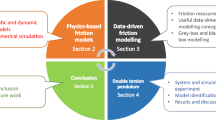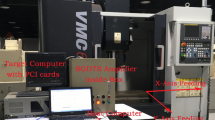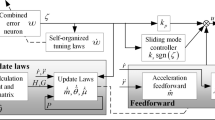Abstract
Friction has a substantial impact on the performance of machine feed systems, and establishing a high-precision friction model is the main premise of model-based friction compensation. To address the low accuracy and difficult parameter identification of the mathematical friction model, as well as the generalization issue of the neural network model, a novel friction model called LuGre-Net that combines the framework of the mathematical LuGre model with a neural network is proposed in this paper. Inspired by the formulas of the LuGre model, the topology of LuGre-Net is developed, with the ranges of LuGre's parameters incorporated into the LuGre-Net network as a priori knowledge. The experimental results demonstrate that the proposed LuGre-Net achieves great prediction accuracy, with a root mean square error (RMSE) and maximum absolute error (MAE) of 0.04 and 0.13 Nm on the test set, respectively. The RMSE of LuGre-Net is 63.9 and 17.8% lower than that of LuGre and the back propagation neural network (BPNN), respectively, while the MAE of LuGre-Net is 53.7 and 38.1% lower. Additionally, LuGre-Net outperforms BPNN in terms of generalization and sample dependence.




















Similar content being viewed by others
Data Availability
The datasets generated during and/or analysed during the current study are not publicly available due to the datasets also forms part of an ongoing study, but are available from the corresponding author on reasonable request.
References
Niranjan, P., Karinka, S., Sairam, K.V.S.S., Upadhya, A., Shetty, S.: Friction modeling in servo machines: a review. Int. J. Dyn. Control 6(3), 893–906 (2018). https://doi.org/10.1007/s40435-017-0353-3
Liu, C., Tsai, M., Cheng, C.: Development of a novel transmission engaging model for characterizing the friction behavior of a feed drive system. Mech. Mach. Theory 134, 425–439 (2019). https://doi.org/10.1016/j.mechmachtheory.2019.01.009
Du, F., Li, P., Wang, Z., Yue, M., Feng, X.: Modeling, identification and analysis of a novel two-axis differential micro-feed system. Precis. Eng. 50, 320–327 (2017). https://doi.org/10.1016/j.precisioneng.2017.06.005
Olsson, H., Åström, K.J., Canudas De Wit, C., Gäfvert, M., Lischinsky, P.: Friction models and friction compensation. Eur. J. Control 4(3), 176–195 (1998). https://doi.org/10.1016/S0947-3580(98)70113-X
Huang, S., Liang, W., Tan, K.K.: Intelligent friction compensation: a review. IEEE/ASME Trans. Mech. 24(4), 1763–1774 (2019). https://doi.org/10.1109/TMECH.2019.2916665
Wan, M., Dai, J., Zhang, W., Xiao, Q., Qin, X.: Adaptive feed-forward friction compensation through developing an asymmetrical dynamic friction model. Mech. Mach. Theory 170, 104691 (2022). https://doi.org/10.1016/j.mechmachtheory.2021.104691
Roveda, L., Pallucca, G., Pedrocchi, N., Braghin, F., Tosatti, L. M.: Cartesian tasks oriented friction compensation through a reinforcement learning approach. In: 2016 IEEE International Conference on Advanced Intelligent Mechatronics (AIM), Banff, AB, Canada, pp. 895–900 (2016). https://doi.org/10.1109/AIM.2016.7576882
Altintas, Y., Erkorkmaz, K., Zhu, W.H.: Sliding mode controller design for high speed feed drives. CIRP Ann. 49(1), 265–270 (2000). https://doi.org/10.1016/S0007-8506(07)62943-6
Peng, H., Song, N., Li, F., Tang, S.: A mechanistic-based data-driven approach for general friction modeling in complex mechanical system. J. Appl. Mech. (2022). https://doi.org/10.1115/1.4054484
Wang, Y., Chen, Z., Zu, H., Zhang, X.: An optimized RBF Neural network based on beetle antennae search algorithm for modeling the static friction in a robotic manipulator joint. Math. Probl. Eng. 2020, 1–10 (2020). https://doi.org/10.1155/2020/5839195
Yu, X., Sun, Y., Wu, S.: Analytically decoupling of friction coefficient between mixed lubricated fractal surfaces. Int. J Mech. Sci. 255, 108465 (2023). https://doi.org/10.1016/j.ijmecsci.2023.108465
Coulomb, C. A.: Théorie des machines simples, en ayant égard au frottement de leurs parties, et à la roideur des cordages. Bachelier (1809)
Bo, L.C., Pavelescu, D.: The friction-speed relation and its influence on the critical velocity of stick-slip motion. Wear 82(3), 277–289 (1982). https://doi.org/10.1016/0043-1648(82)90223-X
Dahl, P.R.: Solid friction damping of mechanical vibrations. AIAA J. 14(12), 1675–1682 (1976). https://doi.org/10.2514/3.61511
De Wit, C.C., Olsson, H., Astrom, K.J., Lischinsky, P.: A new model for control of systems with friction. IEEE T. Automat. Contr. 40(3), 419–425 (1995). https://doi.org/10.1109/9.376053
Al-Bender, F., Lampaert, V., Swevers, J.: The generalized Maxwell-slip model: a novel model for friction simulation and compensation. IEEE T Automat. Contr. 50(11), 1883–1887 (2005). https://doi.org/10.1109/TAC.2005.858676
Mnich, K., Lazarek, M., Stefanski, A., Perlikowski, P.: Identification of friction in inerter with constant and variable inertance. Meccanica 57(8), 1955–1973 (2022). https://doi.org/10.1007/s11012-022-01547-z
Milcic, D., Alsammarraie, A., Madic, M., Krstic, V., Milcic, M.: Predictions of friction coefficient in hydrodynamic journal bearing using artificial neural networks. J. Mech. Eng. (2021). https://doi.org/10.5545/sv-jme.2021.7230
Tu, X., Zhou, Y., Zhao, P., Cheng, X.: Modeling the static friction in a robot joint by genetically optimized BP neural network. J. Intell. Robot. Syst. 94(1), 29–41 (2019). https://doi.org/10.1007/s10846-018-0796-6
Chu, Z., Chen, G., Cui, J., Wang, S., Sun, F.: Classifier-based approximator for friction compensation in high accelerated positioning system. IEEE T Ind. Electron. 68(5), 4090–4098 (2021). https://doi.org/10.1109/TIE.2020.2987268
Von Rueden, L., Mayer, S., Beckh, K., Georgiev, B., Giesselbach, S., Heese, R., Kirsch, B., Pfrommer, J., Pick, A., Ramamurthy, R., Walczak, M.: Informed machine learning—a taxonomy and survey of integrating prior knowledge into learning systems. IEEE T Knowl. Data. En. 35(1), 614–633 (2023). https://doi.org/10.1109/TKDE.2021.3079836
Karniadakis, G.E., Kevrekidis, I.G., Lu, L., Perdikaris, P., Wang, S., Yang, L.: Physics-informed machine learning. Nat. Rev. Phys. 3(6), 422–440 (2021). https://doi.org/10.1038/s42254-021-00314-5
Xu, T., Valocchi, A.J.: Data-driven methods to improve baseflow prediction of a regional groundwater model. Comput Geosci-UK 85, 124–136 (2015). https://doi.org/10.1016/j.cageo.2015.05.016
Fu, T., Zhang, T., Cui, Y., Song, X.: Novel hybrid physics-informed deep neural network for dynamic load prediction of electric cable shovel. Chin. J. Mech. Eng. 35(1), 147 (2022). https://doi.org/10.1186/s10033-022-00817-x
Gokhale, G., Claessens, B., Develder, C.: Physics informed neural networks for control oriented thermal modeling of buildings. Appl. Energ. 314, 118852 (2022). https://doi.org/10.1016/j.apenergy.2022.118852
Zhang, R., Liu, Y., Sun, H.: Physics-guided convolutional neural network (PhyCNN) for data-driven seismic response modeling. Eng. Struct. 215, 110704 (2020). https://doi.org/10.1016/j.engstruct.2020.110704
Raissi, M., Perdikaris, P., Karniadakis, G.E.: Physics-informed neural networks: a deep learning framework for solving forward and inverse problems involving nonlinear partial differential equations. J. Comput. Phys. 378, 686–707 (2019). https://doi.org/10.1016/j.jcp.2018.10.045
Di Natale, L., Svetozarevic, B., Heer, P., Jones, C.N.: Physically consistent neural networks for building thermal modeling: theory and analysis. Appl. Energ. 325, 119806 (2022). https://doi.org/10.48550/arXiv.2112.03212
Guo, C., Chen, L., Ding, J.: A novel dynamics model of ball-screw feed drives based on theoretical derivations and deep learning. Mech. Mach. Theory 141, 196–212 (2019). https://doi.org/10.1016/j.mechmachtheory.2019.07.011
Jiang, Y., Chen, J., Zhou, H., Yang, J., Xu, G.: Residual learning of the dynamics model for feeding system modelling based on dynamic nonlinear correlate factor analysis. Appl. Intell. 51(7), 5067–5080 (2021). https://doi.org/10.1007/s10489-020-02096-2
Kemal Cılız, M., Tomizuka, M.: Friction modelling and compensation for motion control using hybrid neural network models. Eng. Appl. Artif. Intel. 20(7), 898–911 (2007). https://doi.org/10.1016/j.engappai.2006.12.007
Lutter, M. , Ritter, C., Peters, J.: Deep Lagrangian Networks: Using Physics as Model Prior for Deep Learning (2019). https://doi.org/10.48550/arXiv.1907.04490
Cheng, Y., Li, Y., Liu, X., Cai, Y.: Mechanism-based structured deep neural network for cutting force forecasting using CNC inherent monitoring signals. IEEE/ASME Trans. Mechatron. 27(4), 2235–2245 (2022). https://doi.org/10.1109/TMECH.2021.3100719
Jin, W., Niancong, L., Jianlong, C., Weitao, G.: Adaptive control of servo system based on LuGre model. IOP Conf. Ser: Mater. Sci. Eng. 339(1), 12006 (2018). https://doi.org/10.1088/1757-899X/339/1/012006
Zhang, W., Li, M., Gao, Y., Chen, Y.: Periodic adaptive learning control of PMSM servo system with LuGre model-based friction compensation. Mech. Mach. Theory 167, 104561 (2022). https://doi.org/10.1016/j.mechmachtheory.2021.104561
Johanastrom, K., Canudas-de-Wit, C.: Revisiting the LuGre friction model. IEEE Contr. Syst. Mag. 28(6), 101–114 (2008). https://doi.org/10.1109/MCS.2008.929425
Acknowledgements
This research is funded by Department of Science and Technology of Hubei Province (2021AAB001). We also acknowledge the comments of anonymous reviewers.
Funding
This work was supported by Department of Science and Technology of Hubei Province (2021AAB001). Author Jianzhong Yang has received research support from Department of Science and Technology of Hubei Province.
Author information
Authors and Affiliations
Contributions
All authors contributed to the study conception and design. Formal analysis is performed by Dehai Huang, Jianzhong Yang, Guangda Xu. Methods are mainly implemented by Dehai Huang, Guangda Xu. Algorithm programming and experimental verification are mainly implemented by Jiakang Chen, Dehai Huang. Funding acquisition and project administration were performed by Jianzhong Yang. The first draft of the manuscript was written by Dehai Huang and all authors commented on previous versions of the manuscript.
Corresponding author
Ethics declarations
Competing interests
The authors have no relevant financial or non-financial interests to disclose.
Additional information
Publisher's Note
Springer Nature remains neutral with regard to jurisdictional claims in published maps and institutional affiliations.
Rights and permissions
Springer Nature or its licensor (e.g. a society or other partner) holds exclusive rights to this article under a publishing agreement with the author(s) or other rightsholder(s); author self-archiving of the accepted manuscript version of this article is solely governed by the terms of such publishing agreement and applicable law.
About this article
Cite this article
Huang, D., Yang, J., Xu, G. et al. LuGre-Net: a hybrid neural network for friction modeling of feed systems in machine tools. Nonlinear Dyn (2024). https://doi.org/10.1007/s11071-024-09674-w
Received:
Accepted:
Published:
DOI: https://doi.org/10.1007/s11071-024-09674-w




